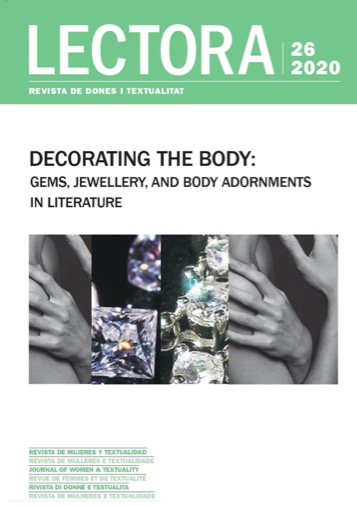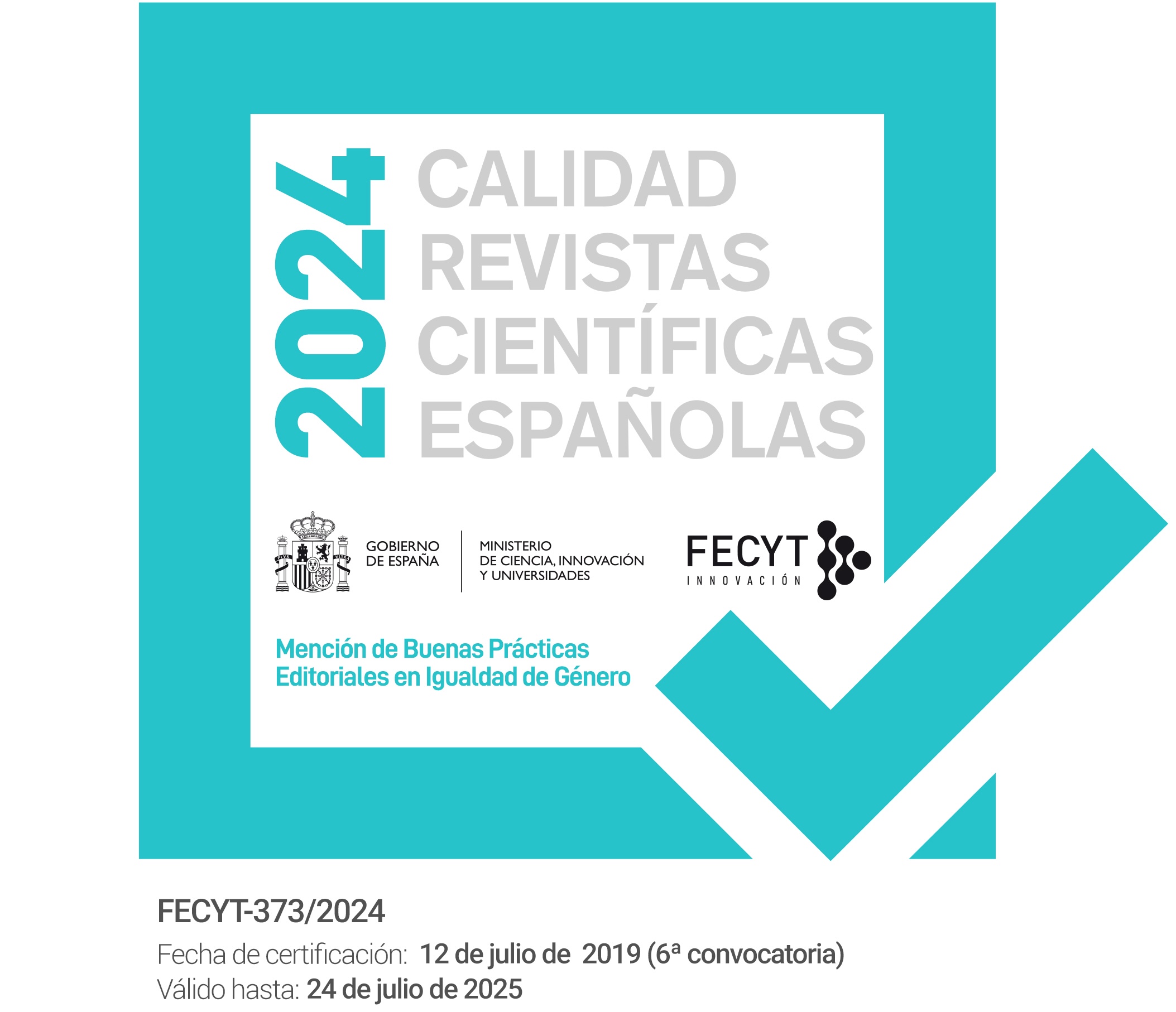Sensorialidad y joyería hecha con cabello humano en la ficción y cultura neo-victorianas
DOI:
https://doi.org/10.1344/Lectora2020.26.6Palabras clave:
joyería realizada con cabello humano, cultura material, época victoriana, neo-VictorianismoResumen
En este artículo me centro en el papel que desempeña la joyería realizada con cabello humano, un arte muy extendido en el siglo XIX y en el contexto anglonorteamericano, en la literatura y en la cultura neo-victorianas. Analizaré estas joyas como objetos que provienen del pasado victoriano, pero también como artículos personales que estimulan respuestas emocionales y afectivas a través de los sentidos. En esta aproximación al neo-Victorianismo, me ocupo del entramado e imbricación que se crea entre sujeto y objeto, entre restos humanos (el pelo) y las joyas, entre el pasado y el presente, entre la muerte y la vida en versiones contemporáneas del arte victoriano de la joyería realizada con cabello humano. En definitiva, mi argumento gira en torno a la capacidad de las huellas materiales de la época victoriana de mediar entre el pasado victoriano y nuestras respuestas sensoriales ya que nos permiten dilucidar las relaciones afectivas entre sujeto y objeto, el pasado y el presente, así como su influencia e impacto sobre nuestro futuro.
Citas
Arnold, Jean (2011), Victorian Jewelry, Identity, and the Novel: Prisms of Culture, London & New York, Routledge.
Bachman, Maria K. (2016), "Dickens's Evocative Objects: A Tale of Two Lockets", Dickens Quarterly, 33 (1): 38-54.
Berry, Esther R. (2019), "Hurricane Katrina Hair: Rereading Nineteenth-Century Commemorative Hair Forms and Fragments Through the 'Mourning Portraits' of Loren Schwerd", Fashion Studies, 2 (1): 1-44.
Boehm, Katharina (2012), "Introduction: Bodies and Things", Bodies and Things in Nineteenth-Century Literature and Culture, Katharina Boehm (ed.), Basingstoke, Palgrave Macmillan: 1-16.
Brontë, Charlotte (1993), Villette, Sandra Kemp (ed.), London, Everyman. [1853]
Brontë, Emily (1995), Wuthering Heights, Pauline Nestor (ed.), Harmondworth, Penguin. [1847]
Brown, Bill (2001), "Thing Theory", Critical Inquiry, 28 (1): 1-22.
—(2003), A Sense of Things: The Object Matter of American Literature, Chicago, University of Chicago Press.
Browne, Victoria (2014), Feminism, Time, and Nonlinear History, Basingstoke, Palgrave Macmillan.
Chidgey, Catherine (2005), The Transformation: A Novel, New York, Picador.
Cohen, William A. (2009), Embodied: Victorian Literature and the Senses, Minneapolis & London, University of Minnesota Press.
Collins, Wilkie (1992), The Moonstone, Catherine Peters (ed.), New York & London, Alfred A. Knopf.
Cox, Jessica (2017), "Neo-Victorianism", Oxford Bibliographies. DOI: 10.1093/OBO/9780199799558-0083.
Department for Culture, Media and Sport (DCMS) (2005), Guidance for the Care of Human Remains in Museums, London, DCMS.
Dickens, Charles (1996), Oliver Twist, Salt Lake City, Project Gutenberg. <http://www.gutenberg.org/ebooks/730> [1838]
Fox, Essie (2013), The Goddess and the Thief, London, Orion.
Gamble, Sarah (2009), "'You Cannot Impersonate What You Are': Questions of Authenticity in the Neo-Victorian Novel", LIT: Literature, Interpretation, Theory, 20 (1-2): 126-40.
Gilbert, Pamela K. (2019), Victorian Skin: Surface, Self, History, Ithaca & London, Cornell UP.
Hamilakis, Yannis (2013), Archaeology of the Senses: Human Experience, Memory, and Affect, Cambridge, Cambridge UP.
Hardy, Thomas (1993), Far from the Madding Crowd, Ware, Wordsworth.
Heilmann, Ann, and Mark Llewellyn (2010), Neo-Victorianism: The Victorians in the Twenty-First Century, 1999-2009, Basingstoke, Palgrave Macmillan.
Hodder, Ian (2012), Entangled: An Archaeology of the Relationships between Humans and Things, Chichester, Wiley-Blackwell.
Jordan, Justine (2005), "Cutting Edge", Review of Catherine Chidgey's The Transformation, The Guardian, 09/04/05. <https://www.theguardian.com /books/2005/apr/09/featuresreviews.guardianreview8>
Lutz, Deborah (2015a), The Brontë Cabinet: Three Lives in Nine Objects, London & New York, W. W. Norton.
—(2015b), Relics of Death in Victorian Literature and Culture, Cambridge, Cambridge UP.
Maxwell, Catherine (2017), Scents and Sensibility: Perfume in Victorian Literary Culture, Oxford, Oxford UP.
Newton, Grace (2019), "£25 Antiques Roadshow ring found to contain lock of Charlotte Brontë's hair", Yorkshire Post, 22/11/2020. <https://www.yorkshire post.co.uk/heritage-and-retro/heritage/ps25-antiques-roadshow-ring-found- contain-lock-charlotte-brontes-hair-1756508>
Ofek, Galia (2009), Representations of Hair in Victorian Literature and Culture, Farnham, Ashgate Publishing.
Parkins, Wendy (2009), "Trust your Senses?: An Introduction to the Victorian Sensorium", Australasian Journal of Victorian Studies, 14 (2): 1-7.
Pointon, Marcia (1999), "Materializing Mourning: Hair, Jewellery and the Body", Material Memories: Design and Evocation, Marius Kwint, Christopher Breward, and Jeremy Aynsley (eds.), Oxford and New York, Berg: 39-57.
Purcell, Laura (2019), Bone China, London, Raven Books.
Ricoeur, Paul (1985), Time and Narrative Volume 3, Kathleen Blamey and David Pellauer (trans.), Chicago & London, University of Chicago Press.
Sattaur, Jennifer (2012), "Thinking Objectively: An Overview of 'Thing Theory' in Victorian Studies", Victorian Literature and Culture, 40: 347-57.
Tarlo, Emma (2016), Entanglement: The Secret Lives of Hair, London, Oneworld.
Thomas, Julian (2006), "Phenomenology and Material Culture", Handbook of Material Culture. Chris Tilley, Webb Keane, Susanne Kueschler, Mike Rowlands, and Patricia Spyer (eds.), London, SAGE: 42-59.
Wildgoose, Jane (2019), "Beyond All Price: Victorian Hair Jewelry, Commemoration & Story-Telling", Fashion Theory: The Journal of Dress, Body and Culture, 22 (6): 699-726.
Yan, Shu-chuan (2019), "The Art of Working in Hair: Hair Jewellery and Ornamental Handiwork in Victorian Britain", The Journal of Modern Craft, 12 (2): 123-139.
Descargas
Publicado
Cómo citar
Número
Sección
Licencia
Los autores y las autoras conservan los derechos de autoría y otorgan a Lectora: revista de dones i textualitat el derecho de difusión. La obra estará disponible simultáneamente bajo una Licencia de Reconocimiento-NoComercial-SinObraDerivada de Creative Commons que, si no se indica lo contrario, permite compartir la obra con terceros, siempre que estos reconozcan la autoría y la publicación inicial en esta revista.Los autores y autoras son libres de hacer acuerdos contractuales adicionales independientes para la distribución no exclusiva de la versión de la obra publicada en la revista (como la publicación en un repositorio institucional o en un libro), siempre que se reconozca la publicación inicial en esta revista.Se alienta a los autores y autoras a publicar su obra en línea (en repositorios institucionales, temáticos o en su página web, por ejemplo) con el objetivo de conseguir intercambios productivos y hacer que la obra obtenga mayor difusión y citas (véase The Effect of Open Access, en inglés).




